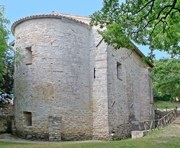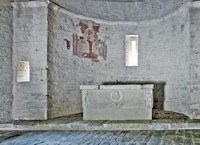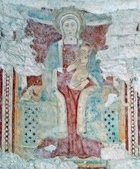
According to tradition, St Romuald founded this abbey, which is first documented in 1025. It was dedicated to St Sylvester I (the pope most associated with the Emperor Constantine). Pope Eugenius III placed it under the jurisdiction of to the Camaldolesian Order in 1150, but it retained a large measure of independence. In 1178, Pope Alexander III, with the bull Religiosam vitam, took it into papal protection and confirmed its extensive holdings, which included Santa Maria Maggiore, Sant' Andrea, San Claudio, San Severino and San Rufino, as well as the nunnery) and others churches throughout the dioceses of Spoleto, Perugia and Foligno.
The first indication of decadence the abbey came in 1187, when the Emperor Henry IV removed Santa Maria Maggiore and San Severino from its control. Pope Gregory IX, who suspected the monks of imperial sympathies, instructed Bartolomeo Accoramboni of Spoleto to suppress the abbey and to transfer much of its property to the nuns of two nunneries that had joined his new Order of Poor Ladies of San Damiano:
-
✴Santa Maria di Vallegloria, not far from the abbey; and
-
✴Santa Maria inter Angelos, Spoleto.
The rest of the property, including the abbey itself, passed to the diocese of Spoleto.
The monks were restored by 1253, but they never regained their old power.
A bitter dispute arose in 1265, when two abbots were elected at San Pietro in Bovara, outside Trevi:
-
✴Grifo, a monk from Todi: and
-
✴Ruggero, abbot of San Silvestro.
Pope Bonifacio VIII mandated Gerardo, bishop of Spoleto, to adjudicate, and he ruled in favour of Ruggero, who remained in post until his death in 1335.
The abbey was apparently destroyed by soldiers in 1363 and rebuilt by Bartolomeo di Cecca, who gave it to the Camaldolese Order in 1364. Bishop Giacomo Muti of Spoleto tried to effect a formal Episcopal Visit in 1374: when Prior Angelo di Simone offered to admit him, but only as a simple priest and a friend, the offended bishop excommunicated the monks, but they continued to claim exemption from episcopal jurisdiction.
By the 16th century, San Silvestro was serving as the parish church of the village of Collepino. In 1534, Pope Paul III ordered the destruction of the monastery (along with the walls of Collepino) because he suspected that supporters of the Baglioni family found refuge here.
In 1972, Sister Maria Teresa dell' Eucaristia acquired the site and built the Eremo della Trasfigurazione here for the Piccole Sorelle di Maria, the order that she had founded.
Exterior

[Remains of the campanile ?]
Interior


The inscription (probably 1st century AD) in front of the altar (just visible in this photograph) reads:
.... [AQV]AM ADDV[XIT] ....
.... brought water ....
It probably came from the nearby Roman aqueduct. (There are better pictures of the altar and the inscription in Bill Thayer’s website).
Madonna and Child (15th century)

Crypt

The crypt is a rectangular room with three Roman columns (at least one of which is upside down) that support the vault. Most of the building materials, including those that were used for the altar, have an ancient (predominantly Roman) provenance.






